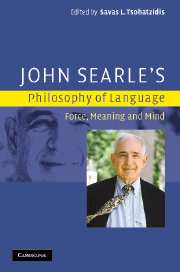Book contents
- Frontmatter
- Contents
- List of contributors
- Acknowledgments
- Introduction
- 1 What is language: some preliminary remarks
- PART I FROM MIND TO MEANING
- PART II FROM MEANING TO FORCE
- 8 How to say things with words
- 9 Semantics without the distinction between sense and force
- 10 Dynamic discourse semantics for embedded speech acts
- 11 Yes–no questions and the myth of content invariance
- 12 How do speech acts express psychological states?
- References
- Index
10 - Dynamic discourse semantics for embedded speech acts
Published online by Cambridge University Press: 08 January 2010
- Frontmatter
- Contents
- List of contributors
- Acknowledgments
- Introduction
- 1 What is language: some preliminary remarks
- PART I FROM MIND TO MEANING
- PART II FROM MEANING TO FORCE
- 8 How to say things with words
- 9 Semantics without the distinction between sense and force
- 10 Dynamic discourse semantics for embedded speech acts
- 11 Yes–no questions and the myth of content invariance
- 12 How do speech acts express psychological states?
- References
- Index
Summary
INTRODUCTION
A traditional separation of pragmatics and semantics has it that speech acts are computed at the level of the entire sentence and that their illocutionary force cannot be embedded under various truth conditional operators. To quote from David Lewis (1972: 209):
the entire apparatus of referential semantics pertains to sentence radicals and constituents thereof. The semantics of mood is something entirely different. It consists of rules of language use such as … React to a sentence representing the mood imperative with an S-meaning m, by acting in such a way as to make m true.
Since speech acts other than assertions do not classically have truth values as extensions (Searle 1969; Vanderveken 1990), they cannot possibly combine with truth-functional operators like the propositional connectives in standard logic. This much is right. But when we look at the behavior of natural language conjunctions such as and, or, or if… then, speech acts such as directives and questions clearly embed under some of these operators. As Krifka (2001, 2002) has argued, considerable evidence has amassed over the years that most types of speech acts do embed within conjunctions and conditionals, and imperatives clearly embed under disjunctions. The problematic question for truth conditional semantics is then: what is the uniform account of the meaning of natural language sentential connectives that captures their behavior with interrogatives, imperatives, and indicatives?
Several decades of research have shown that this question is difficult if not impossible to answer within the confines of standard truth conditional semantics.
Information
- Type
- Chapter
- Information
- John Searle's Philosophy of LanguageForce, Meaning and Mind, pp. 211 - 243Publisher: Cambridge University PressPrint publication year: 2007
